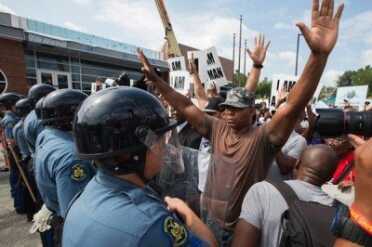Arguably, we’ve been conditioned by the media to believe that there is a bias when it comes to the use of deadly force against minorities, in particular black people.
A couple of recent studies conducted by Washington State University seem to have turned this belief on its head.
According to one study, when confronted with an armed white suspect versus an armed black or hispanic suspect, the participants were quicker to pull the trigger against the white suspect when compared to the black suspect or hispanic suspect.
It took participants 1.37 seconds to shoot back at an armed white suspect compared to 1.61 seconds to shoot back at an armed black suspect. Those firing at the black suspects were also less likely to make an error. While that may not seem like a huge disparity, in a life and death situation, every second counts.
Another fascinating finding was that participants were more likely to mistakenly shoot an unarmed white suspect than an unarmed black or hispanic suspect. Participants also failed more often to fire back at an armed black suspect when compared to that of an armed white suspect.
“In other words, there was significant bias favoring blacks where decisions to shoot were concerned,” wrote Lois James, the lead author of the study and the assistant research professor at WSU Spokane’s Sleep and Performance Research Center.
The study was conducted using laser-equipped guns in a full-size, high-definition simulator, in WSU Spokane’s Simulated Hazardous Operational Tasks Laboratory or SHOT lab. The simulator can control for a number of different variables, including the suspect’s race, clothing, hand positions, body stance (threatening or non-threatening) and calculates how long it takes an individual to fire back.

Protests in Ferguson, Missouri, following the shooting death of 18-year-old Michael Brown. (Photo: Missouri Lawyers)
The other study measured participants alpha brain waves, using data from electroencephalograph sensors, to determine what races the participants found most threatening.
Participants, 85 percent of whom were white, “demonstrated significantly greater threat responses against black suspects than white or Hispanic suspects,” wrote James and her co-authors, suggesting that participants “held subconscious biases associating blacks and threats.”
So, on one hand, participants find blacks more threatening, but on the other, they are slower to engage them in a deadly force scenario. The question is why? To which the authors suggested that there may be a ‘counter-bias’ “rooted in people’s concerns about the social and legal consequences of shooting a member of a historically oppressed racial or ethnic group.”
As it relates to the law enforcement community in particular, which was included in the first study measuring response time but not in the second study examining perceived threats, James notes that there are still questions that need to be answered.
“At the moment, there are no comprehensive statistics on whether the police do inappropriately shoot at black males more than they do at white males,” said James.
“Although isolated incidents of black males being shot by the police are devastating and well documented, at the aggregate level we need to understand whether the police are shooting black unarmed males more than they are white unarmed males. And at the moment, nobody knows that,” explained James.
